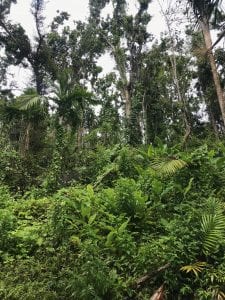Current Research Projects:
1. Taking advantage of the impact of the recent Category 4 Hurricane Maria in Puerto Rico to evaluate the Janzen-Connell hypothesis for species coexistence. Co-pi with Krista McGuire on a RAPID grant from NSF.
2. Understanding the diversity, ecology and evolution of Xylariaceae in tropical forests
Fungi in the genus Xylariaceae are important because they are common primary decomposers in the tropics and are thus players in the global carbon cycle. They are also present in the leaves of most plants as endophytes (present but not showing pathogenic symptoms). Finally, they are strongly associated with insects and several species are found only in termite mounds. Despite their ecological importance, the biodiversity, distributions, lifecycles and insect associations of these fungi remain poorly understood. We are collecting, identifing, describing and comparing the diversity of Xylariaceae and associated insects across tropical biodiversity hotspots using standardized and comparable methods. We are also performing experiments to better understand the ecology and lifecycles of these fungi.Field sites are in Ecuador, Gabon and Taiwan thus far.
3. How will global warming influence plant-associated fungi (pathogens and endophytes)?

Two different projects have been initiated to address this question.
First, in collaboration with Christa Mulder (University of AK, Fairbanks, http://mercury.bio.uaf.edu/~christa_mulder/CV.htm), we are examining the effects of climate change on the parasites of alders and other common understory plant species in the boreal forest.
Second, in collaboration with Scott Bridgham, Bart Johnson, Laurel Pfiefer-Meister, Bill Morris, Dan Doak and Mitch Cruzan we are examining climate change in the context of PNW prairies and range-limited plants. We are using three different tools: 1) a climate modification experiment (heating and rainfall manipulation) at three sites across the PNW longitudinal gradient, 2) demography in natural populations of the same species that are in the experiment, 3) landscape genetics.
Field sites range from near the S. border of Oregon to Whidbey Island in Washington State.
4. Pacific Northwest Prairie Fungi: What, when, where and why
Prairies were once much more extensive in the Pacific Northwest, but have largely been lost due to Euro-American settlement, agriculture and changes in the fire regime. It has long been appreciated that remnant prairies contain a large number of now rare plant species, but it is not known whether there might also be a prairie-associated mycoflora, which may also contain species of conservation interest. Our goal is to remedy this st ate of ignorance.
ate of ignorance.
This is a collaborative project with Susie Homes (Lane Community College), and Sarah Hammon (Evergreen State College and Center for Natural Lands Management). We are relying on the help of many others, including Wes Messinger (Army Corps of Engineers), Bruce Newhouse (Salix and Associates), and people associated with The Institute of Applied Ecology, including: Tom Kaye, Denise Giles-Johnson. In the future, we hope to pull in additional volunteers from the Cascade Mycological Society, and to sample prairies managed by other agencies, such as the TNC and BLM.
Students are encouraged to apply to work on this project. We need help with: collecting and identifying mushrooms, website development, data entry, and lab work ranging from microscope work to PCR.


